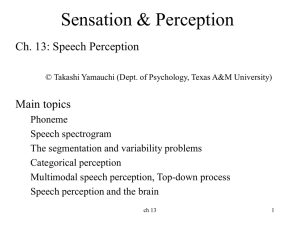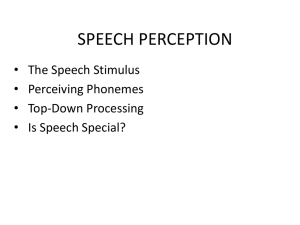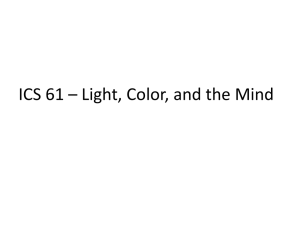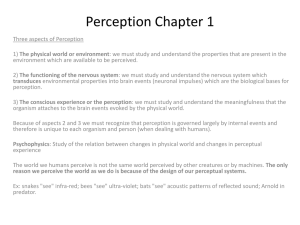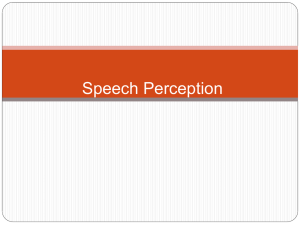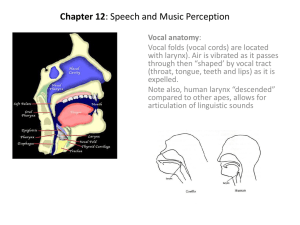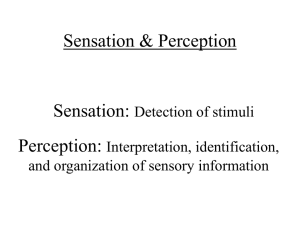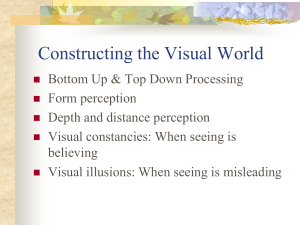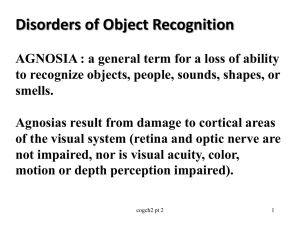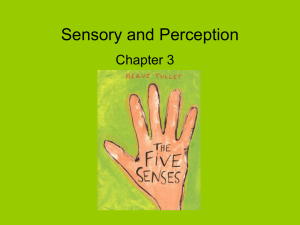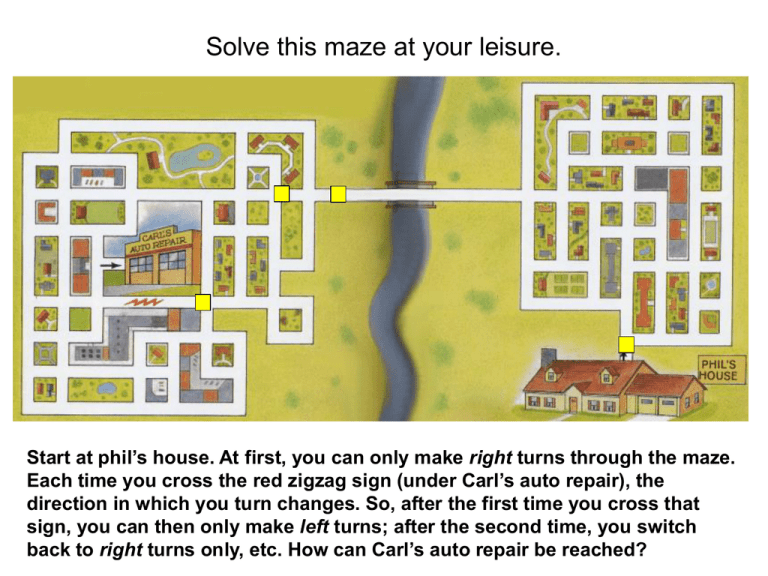
Solve this maze at your leisure.
Start at phil’s house. At first, you can only make right turns through the maze.
Each time you cross the red zigzag sign (under Carl’s auto repair), the
direction in which you turn changes. So, after the first time you cross that
sign, you can then only make left turns; after the second time, you switch
back to right turns only, etc. How can Carl’s auto repair be reached?
Language Part I
Speech Perception
Semantics
Levels of Language
Phonology
Morphology
& Semantics
The
sound
system of a
language
(phonemes)
How a
language
expresses
meaning
(morphemes,
words)
Prosody
How melody
used to
create
meaning
Syntax
The structure
of a language.
Rules for
combining
words
Pragmatics
How
language
is used
Prosody and Intonation
• Aspects of a sentence’s sound that is not specific to the
properties of the words in a sentence
“you made a big deal about it”
“… you want me to do”
Phonology
• The study of the sound patterns of language
• Phoneme: The smallest unit of sound that can be altered
to change the meaning of a word
• In English, the words gin, kin, pin, tin, win all have
different meaning due to the fact that the initial sound, or
phoneme, is different
Speech Perception
• The first step in comprehending spoken language is to
identify the words being spoken, performed in multiple
stages:
1. Phonemes are detected (/b/, /e/, /t/, /e/, /r/, )
2. Phonemes are combined into syllables (/be/ /ter/)
3. Syllables are combined into words (“better”)
4. Word meaning retrieved from memory
Spectrogram: I owe you a yo-yo
How many words were spoken (in Finnish)?
Sound clip 1
“Hyvää huomenta” (two words) “Good morning”
Sound clip 2
“ Kiitoksia oikein paljon” (three words) “Thank you”
Sound clip 3
“Ilmatyynyalukseni on täynnä ankeriaita” (four words)
“My hovercraft is full of Eels”
Speech perception: two problems
• Words are not neatly segmented (e.g., by pauses)
• Difficult to identify phonemes
– Coarticulation = consecutive speech sounds blend
into each other due to mechanical constraints on
articulators
– Speaker differences; pitch affected by age and sex;
different dialects, talking speeds etc.
(as in dumb)
Similarly, /M/ in “Tim” vs. “/M/ in “mad” lead
to different frequency characteristics
How do listeners deal with variability in acoustic input?
• Use of semantic and lexical context:
Phonemic restoration
• Use of visual cues:
McGurk effect
• Continuous changes in input are mapped on to discrete
percepts:
Categorical perception
Phonemic restoration
Auditory presentation
Perception
Legislature
Legi*lature
Legi_lature
legislature
legislature
legi lature
It was found that the *eel was on the axle.
wheel
It was found that the *eel was on the shoe.
heel
It was found that the *eel was on the orange.
peel
It was found that the *eel was on the table.
meal
Warren, R. M. (1970). Perceptual restorations of missing speech sounds. Science, 167, 392-393.
Video (5 secs): McGurk Effect
Speech perception affected by visual information
YOUTUBE:
http://www.youtube.com/watch?v=aFPtc8BVdJk
http://www.youtube.com/watch?v=ypd5txtGdGw
Harry McGurk and John MacDonald in "Hearing lips
and seeing voices", Nature 264, 746-748 (1976).
McGurk Effect
• McGurk effect in video:
– lip movements
= “ga”
– speech sound
= “ba”
– speech perception = “da” (for 98% of adults)
• Demonstrates parallel & interactive processing: speech
perception is based on multiple sources of information,
e.g. lip movements, auditory information.
• Brain makes reasonable assumption that both sources
are informative and “fuses” the information.
Video (11 secs):
another example of the McGurk Effect
Harry McGurk and John MacDonald in "Hearing lips
and seeing voices", Nature 264, 746-748 (1976).
Categorical Perception
• Categorical perception: high level cognitive processes
(i.e., categorization) can influence perceptual processes
Conceptual Knowledge
categorical
perception
Perception of Sounds/Images
Differences among items that fall into different categories
are exaggerated, and differences among items that fall
into the same category are minimized.
(from Rob Goldstone, Indiana University)
Categorical Perception
Adult categorical perception: Voice Onset Time (VOT)
[da]
[ta]
60 ms
(slide courtesy of Lisa Pearl)
Categorical Perception
Identification: Discontinuity at Boundary
Decision between da/ta
Time to make decision
(slide courtesy of Lisa Pearl)
Categorical Perception
• Within-category discrimination is hard, across-category
discrimination is easy
D
0ms
20ms
D
D
20ms
40ms
T
T
40ms
60ms
T
(slide courtesy of Lisa Pearl)
What Happened?
1
2
3
4
5
6
Physical World
7
Perceptual Representation
1 2 3 4
5 6 7 8
8
Categorical Perception depends on language
• In one language a difference in sound may make a
difference – leads to perception of different phonemes; in
another, it might not
• Example: several Asian languages do not distinguish
between /l/ and /r/
• Different languages have different sets of phonemes
Listen to the wonderful singing of this child that has difficulty distinguishing l/r sound:
http://www.youtube.com/watch?v=wgrrQwLdME8
Examples of different phonemes non-existent in English
Hindi
Salish
(Native North American—Canadian—language)
Dental Stop
Retroflex Stop
Uvular
Velar
Infant Speech Perception
• Infants (not adults) can perceive most and
perhaps all phonemes found in human language
• Ability is quickly lost because some sounds not
needed
Diminished Sensitivity to Foreign Language Contrasts
Semantics
Semantics
• The meaning or interpretation of a word, phrase,
or sentence
• Two main theories about how we abstract
meaning
Definitional Theory
of Word Meaning
• The full meaning of each word is captured by a
set of features that are essential for membership
in the class named by the word
Example of using
definitional theory
bachelor:
[single]
[human]
[adult]
[male]
Problem with Definitional Theory
• A thing either fits or doesn’t fit definition
• Doesn’t capture the fact that some members of
category are better exemplars than others
Alfred is an unmarried adult male. He has
been living with his girlfriend for the last
twenty-three years. Their relationship is
happy and stable. Is Alfred a bachelor?
bachelor?
Prototype Theory of Word Meaning
prototype
Prototype Theory of Word Meaning
• family resemblance structure
– Features that appear to be characteristic of category
members but may not be possessed by every
member
• Prototype: the member of a set or category that
captures the greatest number of category features
Mental prototype for chair
A new exemplar is classified based on its similarity to the prototype
Support for prototype theory
• People are quicker at classifying typical than atypical
members
Is this a “cat”?
Is this a “dog”?

